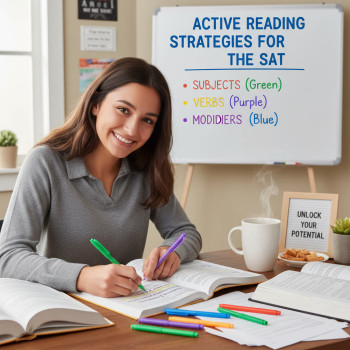Why smart carpooling matters on Digital SAT test day
There’s a special kind of nervous energy in the carpool lane the morning of a big exam. For parents, it’s a mix of logistics, care, and hope — hope that your teen will walk into that test center calm, prepared, and on time. For students, it’s the last few hours where everything they’ve practiced has to click into place. Organized carpooling takes the friction out of those hours. It removes guesswork, reduces anxiety, and gives everyone — parents and students alike — a little more space to breathe.

The Digital SAT is different — and carpool plans should reflect that
The SAT moved to a digital format, which changed a few things about test-day logistics: students may bring their own devices running the Bluebook app, admission tickets are generated through the app, timing is managed by the application, and rules around devices, power, and backup plans are important. All of this means parents must add a few technical checks to the usual carpool checklist.
When you design a carpool plan, think of it as creating a small operations playbook: who drives, who brings chargers, who holds spare pencils, who double-checks IDs, and who is the go-to communicator if anything goes sideways. A little planning before dawn saves a lot of stress later.
First steps: plan early, communicate clearly
Start three to seven days before test day. That timeline gives your group time to confirm attendance, coordinate timing, and troubleshoot device or accommodation concerns. Use a shared document or simple group chat — whatever your group will actually check — and assign clear roles.
Who to invite to the carpool
- Neighbors and classmates who live along the same route or near the same bus stop.
- Families who have flexible work schedules or a parent who’s accustomed to school drop-offs.
- Parents of students with accommodations — they may need earlier arrival or special device setup.
Key roles to assign
- Lead driver: the parent who will start the route and keep to the timeline.
- Backup driver: in case the lead can’t make it or has car trouble.
- Communications coordinator: sends reminders, shares GPS links, and updates the group on any last-minute changes.
- Supplies manager: brings a car bag with chargers, ID checklist, printed admission tickets, pens/pencils, snacks, and a small first-aid kit.
Build a test-day timeline that accounts for the Digital SAT schedule
College Board guidance suggests students arrive early — typically between 7:45 a.m. and 8:00 a.m. — and testing starts after check-in (roughly 15–30 minutes later). Doors often close promptly at 8:00 a.m., and once testing begins, late arrivals may not be admitted. Your carpool timeline needs to get students to the center early enough to settle in, finish Bluebook exam setup if needed, and use the restroom calmly.
| Time Before Test | Action | Who Might Handle It |
|---|---|---|
| 3–7 days out | Confirm attendees, request accommodations info, and confirm test center address and arrival times. | Communications coordinator |
| 1–2 days out | Confirm devices have Bluebook installed and exam setup completed (1–5 days before test). Print admission tickets if possible. | Students + Supplies manager |
| Night before | Pack carpool bag: chargers, printed IDs, spare pencils, snacks, water, and mask (if desired). | Supplies manager |
| Morning of test | Lead driver starts route early; arrive by posted arrival time (often 7:45–8:00 a.m.). If borrowing a College Board device, arrive 30 minutes earlier. | Lead & Backup drivers |
| Immediately after | Pick-up plan for students dismissed at staggered times; quiet dismissal if some students remain testing. | All drivers |
Checklist: what every carpool bag should include
Think of the carpool bag as your student’s last line of defense against small but disruptive problems.
- Printed admission ticket from the Bluebook app (if available) and a screenshot/email copy on the parent’s phone.
- Acceptable photo ID (student should bring their own; parent may double-check before leaving home).
- Chargers and a portable battery pack. Even if the student brings a fully charged device, a power source is a smart backup.
- Spare pencils/pens and extra scratch paper (proctors will collect scratch paper after the test; rules vary so only bring items allowed).
- Small water bottle and a light snack for the testing break.
- Printed list of special accommodation details (if applicable) and the school’s SSD contact info.
- Contact list: phone numbers for parents in the carpool, the test center phone, and a local emergency contact.

Managing devices and Bluebook: a parent-friendly guide
Because the SAT is digital now, device readiness is a core part of logistics. Parents don’t need to become tech experts, but checking a few things takes five minutes and can prevent a major problem.
Device checklist (to be completed 1–5 days before test)
- Download Bluebook and complete the exam setup so the app generates the admission ticket.
- Confirm device compatibility: many common laptops, tablets, and school Chromebooks work, but confirm the student’s device is supported and updated.
- Ensure the device is fully charged and pack a charger + power bank in the carpool bag.
- Turn off system updates and disable automatic sleep modes for the testing period.
- Confirm Wi‑Fi login details if the school center expects students to connect to a local network for check-in.
Pro tip: if a student needs to borrow a device from College Board, they must arrive earlier for device setup. Your carpool must reflect that by picking up those students first or planning an earlier route.
Safety, liability, and clear expectations
When multiple families participate in a carpool, a quick conversation about safety and expectations avoids awkward moments. Keep it short and practical:
- Confirm that all drivers have valid licenses and adequate insurance.
- Agree on a phone-based check-in if the group gets delayed (for example, “text the comms coordinator if you’re more than five minutes behind”).
- Decide how to handle late arrivals: who will wait, and how late is acceptable before the student must register again for a future date?
- Discuss behavior expectations in the vehicle: encourage a calm, focused environment (no last-minute crash study in the car; conversation should be supportive, not stressful).
Contingency planning: because life happens
No plan survives every variable, and that’s okay. What matters is having backup options in place so stress doesn’t cascade.
Common issues and solutions
- Traffic jam on the route: have the communications coordinator alert other families and the test center if necessary; the lead driver should have an alternate route pre-planned.
- Student forgot ID or admission ticket: bring a printed screenshot of the Bluebook admission ticket in the carpool bag; if ID is missing, contact the test center immediately — sometimes exceptions are possible, but plan to have acceptable photo ID ready.
- Device won’t boot or Bluebook fails: spare device or a pre-arranged loaner is ideal. If not available, contact the test center; College Board allows borrowing devices in some situations but requires earlier arrival for setup.
- Sudden illness: have a policy for turning around and picking up the student, or for whether a parent will stay with them. Re-registering for the test may be necessary if they can’t test that day.
How to keep nerves low and focus high during the ride
Car time before a test is precious mental space. Parents can play a powerful role by shaping a calm, confident environment.
- Positive, low-stress talk beats last-minute coaching. Short, affirming comments like “You’ve prepared, and you’re ready” are more effective than quizzing right before the door closes.
- Encourage simple breathing exercises or a five-minute mindfulness check-in in the car to reduce adrenaline spikes.
- Provide a carbohydrate snack like a banana or granola bar — nothing too sugary that could cause a crash mid-test.
- Remind students of basic logistics: “Phone on silent, ID in backpack, charger in the carpool bag.”
What parents should know about accommodations and special needs
Accommodations require planning and approval. Parents of students with SSD-approved accommodations should confirm how those accommodations will work on the digital SAT well before test day and communicate any special timing or arrival needs to the carpool group.
If a student is approved to borrow a device or needs extended time, their arrival time will differ from the standard group. Make sure your carpool plan accounts for staggered arrivals and drop-off points so nobody is left mis-timed.
Sample carpool rota and responsibilities (one week sample)
Below is a simple rota you can adapt. It’s designed for a small neighborhood cluster of four families. Adjust times and names to match your local schedule and test-center arrival window.
| Day | Task | Assigned To |
|---|---|---|
| T – 7 days | Create group chat, list attendees, and confirm test-center address | Communications coordinator (Parent A) |
| T – 3 days | Confirm devices have Bluebook installed and exam setup completed | Students + Parent B |
| T – 1 day | Assemble carpool bag; print admission tickets | Supplies manager (Parent C) |
| Test day morning | Lead driver starts route at agreed time; backup on standby | Lead driver (Parent D) + Backup driver |
| Test day afternoon | Pick-up schedule; check on staggered dismissals | All drivers |
Tips for parents with multiple test-takers or tight schedules
If you’re juggling multiple students or a work schedule that makes morning pickups challenging, consider these strategies:
- Swap driving duties with another parent for the day so you can be available for an evening or afternoon pick-up.
- Use the school’s nearest access point if permitted — some districts allow approved drop-offs that are closer than the main entrance.
- Coordinate with a trusted neighbor who can act as a pickup hub so one parent drives several students to the center instead of multiple short trips.
After the test: quiet pickups and debriefs
Testing rooms dismiss students quietly and at different times, depending on how quickly they finish. Make sure drivers know which students will be released early and which might remain in the room longer. Establish a meeting point that’s easy to find and away from the entrance so students still in the test won’t be disturbed.
A short, supportive debrief on the ride home is helpful — but keep it light. Focus on emotion and resilience, not scores: “How do you feel? Do you want to relax now or talk about the experience?”
How structured support can boost results (and where tutoring fits in)
Well-organized logistics give the student mental bandwidth to perform. Pair that with targeted academic support and the gains are measurable. Personalized tutoring — like Sparkl’s 1-on-1 guidance, tailored study plans, expert tutors, and AI-driven insights — can help students turn nervous energy into confidence. When a student knows the plan for study and test day, they enter the room calmer and more focused.
Carpooling and tutoring together create an ecosystem: consistent practice and feedback during the weeks leading up to the test, combined with reliable, low-stress transportation on test day, multiply the chances of a good performance.
Real-world examples: what worked for other families
Here are a few short, anonymized snapshots of what other parents found effective:
- A four-family rota where the lead driver became the “test-day coordinator.” This parent kept a laminated checklist in the glove compartment and distributed arrival-time reminders, which cut late mornings down to almost zero.
- A neighborhood group that pre-arranged a backup device and power bank. When one student’s laptop experienced a surprise OS update, the spare saved the day and the student made the test without missing a beat.
- A family that combined tutoring sessions with mock-test carpools: students would carpool to a proctored practice test at a local library, then debrief after. That routine normalized test-day rhythms and reduced anxiety significantly.
Quick reference: carpool day-of checklist (printable and pocket-sized)
- Admission ticket (printed + screenshot)
- Valid photo ID
- Fully charged device + charger + power bank
- Spare pencils and small snack
- Contact numbers for carpool group and test center
- Any accommodation paperwork (if relevant)
- Face mask (if student prefers) and small hand sanitizer
Final thoughts: build community, reduce stress, and let the student shine
Organizing a test-day carpool is more than a logistics exercise — it’s an act of community. Parents who co-plan, share backup devices, and support each other’s schedules take pressure off students and create an environment where preparation can actually translate into performance. A calm, predictable morning sets the tone for a focused test session and gives students the best chance to show what they know.
If you’re looking for ways to combine logistics with stronger preparation, consider pairing your carpool routine with structured academic support. Services offering personalized tutoring, tailored study plans, and data-driven feedback can make preparation more efficient. When students arrive at the test calm, well-rested, and confident in their prep, those last nervous minutes in the car become a quiet, comforting ritual instead of a scramble.
One last practical reminder
Run one final dry run: pick a Saturday in the weeks before the test and drive the route at the same time you’ll leave on test day. It only takes one practice trip to reveal a pothole, a tricky turn, or a last-minute parking hiccup. That tiny rehearsal can save a world of stress when the actual morning arrives.
Good luck to all the students — and thank you to the parents who make calm, steady mornings possible. With a little advance planning, a reliable carpool plan, and the right academic support, the Digital SAT day can feel manageable, even empowering.














No Comments
Leave a comment Cancel